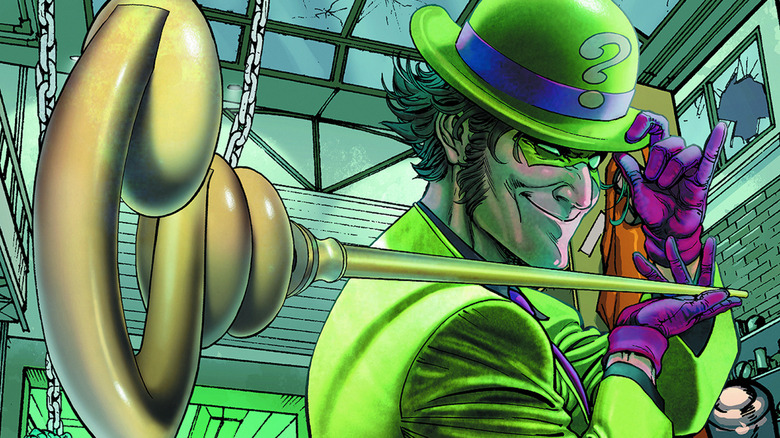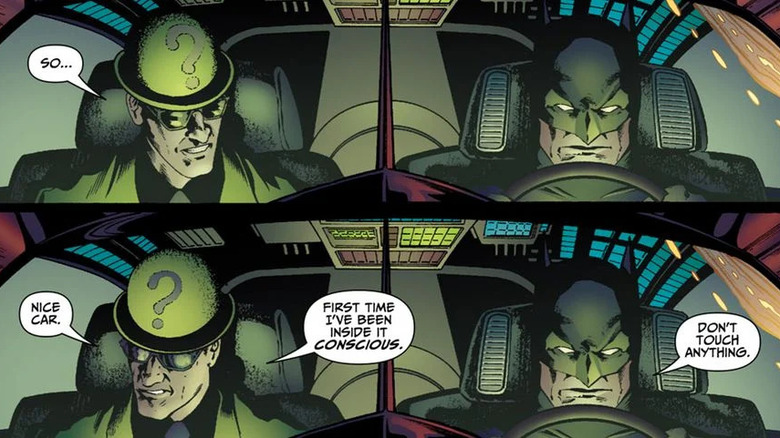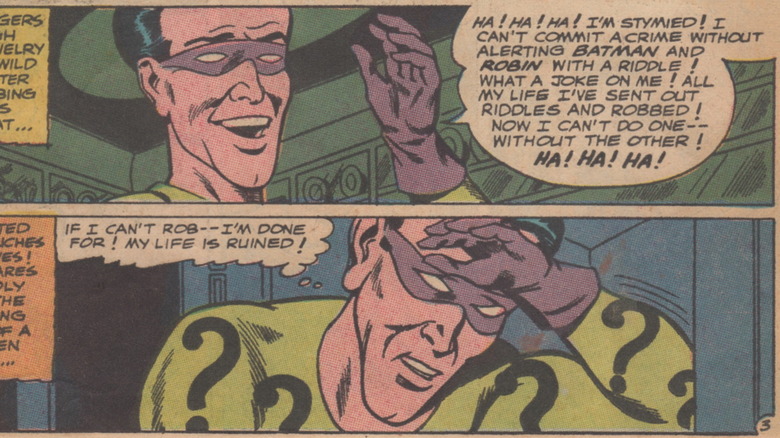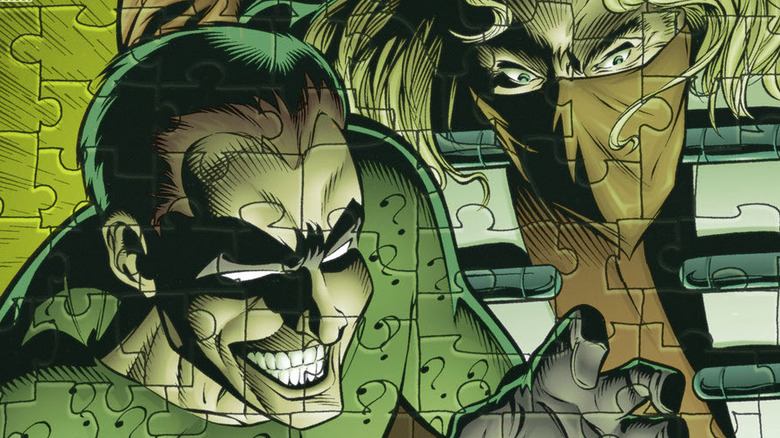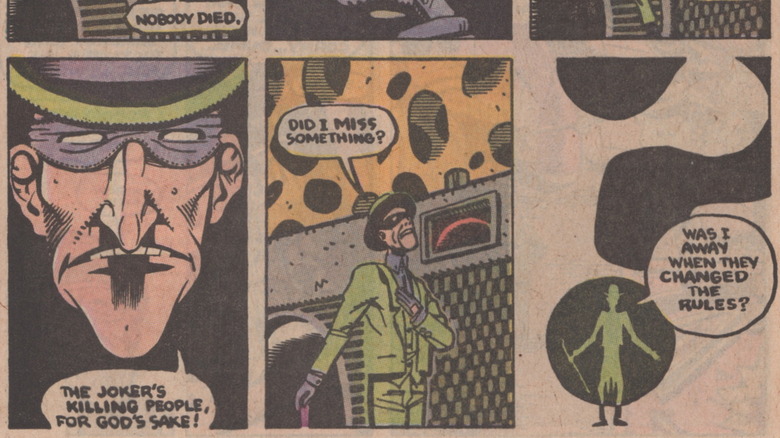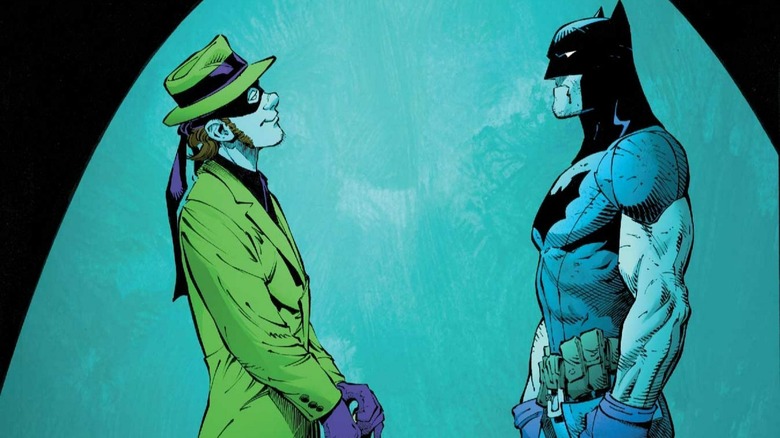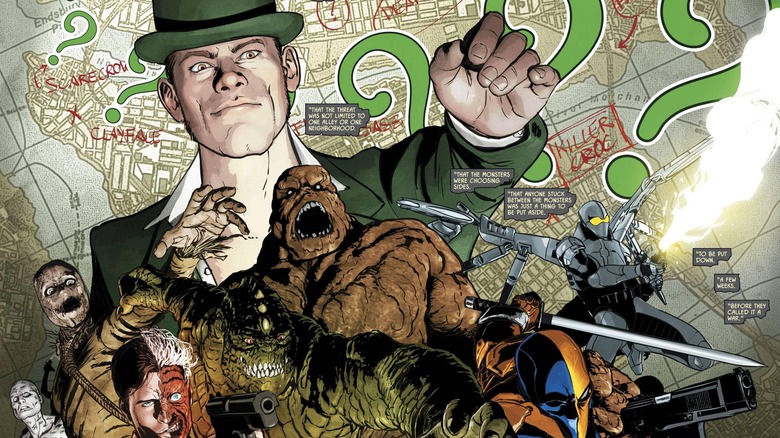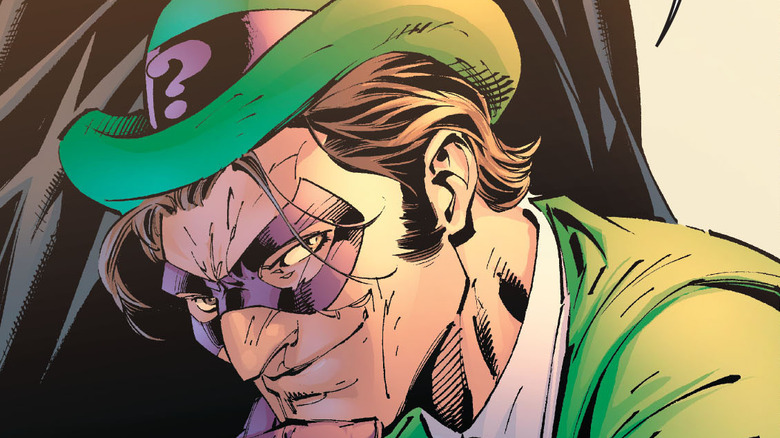The Best Riddler Comics Of All Time
There are many different types of Batman villains, but ultimately, few are a match for Bruce Wayne's tremendous intellect. But there is at least one rogue that frequently attempts to go toe to toe with the Dark Knight in this area: the Riddler. Created by Bill Finger and Dick Sprang in 1948, Edward "E." Nigma (also sometimes spelled Nygma) debuted in "Detective Comics" #140. As his name suggests, the Riddler has a penchant for puzzles or riddles of any kind. In fact, it's more like a compulsion. His look has evolved quite a bit over the years, as he was initially known for his question mark-covered green bodysuit that he chose to accent with a purple domino mask, belt, and gloves. In more modern times, Edward is typically seen in a green suit and bowler hat combo with purple accents, which isn't exactly stealthy, but the villain who sports a question mark cane isn't trying to hide.
The Riddler was memorably played by both Frank Gorshin and John Astin in the 1960s "Batman" TV show, which introduced a generation to the character. More recently on television, he was portrayed by Cory Michael Smith in "Gotham." Of course, he's had movie appearances as well, played by Jim Carrey in "Batman Forever" and now, Paul Dano is portraying the Riddler in Matt Reeves' newest take on the Caped Crusader, "The Batman."
The Riddler has had some long absences throughout his comics history and while his costume has changed, the fundamentals of the character have largely stayed the same. It's kind of tough to find that many great Riddler stories because he's often relegated to a supporting player. Aside from that, a lot of his early stories were kind of similar: Riddler commits crimes but leaves a riddle Batman will inevitably solve, leading to the villain's capture. That's not to say Edward Nigma isn't featured in some excellent tales. So, what are the best Riddler comics?
E. Nigma, Consulting Detective
The Riddler has been thought of as many things, but "hero" was never really one of them. In "E. Nigma, Consulting Detective," Edward decides to try to be just that. Written by Harley Quinn co-creator (and one of my favorite Batman scribes) Paul Dini, the story features excellent art by Don Kramer and Wayne Faucher. The most shocking thing about the Riddler's decision to become a private investigator isn't the supposed clean bill of health he has from Arkham, but rather the fact that he actually makes a decent detective.
This 2006 story in "Detective Comics" #822 might mark the beginning of Edward's time as a P.I., but he pops up throughout Dini's work on the book in other issues as well. It's fun to get a different side of Edward, as well as seeing the Dark Knight begrudgingly working with him. Plus, Dini's entire run is worth reading, so definitely check out the whole thing.
The Riddle-Less Robberies of the Riddler
The Riddler only appeared a couple of times in the '40s before disappearing until the Silver Age. He returned to comics in 1965, shortly before "Batman" hit the small screen in 1966, helping to revive the flailing comic's sales. In fact, the Riddler definitely owed his growing popularity to the character's onscreen portrayal. Edward's second time back was in "Batman" #179, which hit stands shortly after the TV series began airing. Gardner Fox and Sheldon Moldoff were clearly trying to break the already established mold a bit. Edward escapes from prison but realizes committing crimes in his signature style will only land him back there. The rest of the story is about the villain struggling against his compulsion to leave riddles at the scene of his crimes. If you're looking for a fun Riddler story from a different time, this is a pretty good one.
Riddled
This story, which runs from "Detective Comics" #705-707 is told in three parts: "Badd Girls," "Lethal Pursuits," and "Riddled." All three issues are expertly drawn by Graham Nolan and David Roach, and penned by another one of my favorite Bat-family writers, Chuck Dixon — seriously, his "Nightwing" run is fantastic.
The 1997 tale begins with Echo and Query, known pals of the Riddler, abducting the low-rent version of Edward himself: Arthur Brown, aka Cluemaster. The Riddler then escapes from the hospital — he was in for a broken wrist — and using his signature riddles, lures Batman and Robin to the hapless Cluemaster, who's been rigged with explosives. Sure, Arthur would've teamed up with Edward, but the Riddler would rather humiliate the other villain, whom he viewed as "strictly bush league." He threatens to set off the explosives if Bats and the Boy Wonder don't do what he says. I won't reveal Edward's endgame, but you've gotta know it involves ... riddles.
When is a Door: The Secret Origin of the Riddler...
"When is a Door: The Secret Origin of the Riddler..." appears alongside a great Penguin story in "Secret Origins Special" Vol. 2 #1. This 1989 tale is written by none other than Neil Gaiman, creator of "The Sandman," which also launched close to this time. This special begins with another story by Gaiman, "Original Sins," which sees a film crew come to Gotham hoping to interview some of Arkham Asylum's most famed residents. It doesn't go quite the way they'd hoped, but they do get to chat with the Riddler in "When is a Door." It turns out he's been paroled and is currently running a junkyard. Artist Bernie Mireault seems to have a fun time drawing the oversize props littering the area and is very creative in his usage of them. Ultimately, the story comes down to Edward speaking in riddles about his life and larger issues, possibly even stating Gaiman's own feelings on the comic book industry at that time. It's a different kind of Riddler story than what we're used to seeing.
Zero Year
Not everyone was a fan of DC's 2011 New 52 relaunch, but most can agree that one of the best titles to come out of it was Scott Snyder and Greg Capullo's "Batman." It was an excellent reinvention of the character that managed to put a new spin on the Caped Crusader while still maintaining everything that made him so awesome in the first place. The Dark Knight wasn't the only one who got a revamp. His rogues' gallery were also given some impressive updates. For one thing, the Riddler became a true threat.
The 2013 event "Zero Year" takes place across three arcs in "Batman" Vol 2: "Secret City," Dark City," and "Savage City." It begins with issue #21. The Riddler is the true villain of the piece and he's managed to bring the entire city of Gotham under his control. Of course, the only match for him is Batman, but still very new to the cape and cowl, this is a different hero than the one readers had grown accustomed to. Snyder tells a compelling story, but perhaps the real star is Capullo's amazing art.
The War of Jokes and Riddles
Just when you thought DC continuity couldn't get any more confusing, the publisher relaunched all their titles yet again in 2016 with DC Rebirth; similar to the New 52, one of the better books to come out of the revamp was "Batman." Though "The War of Jokes and Riddles" has an engaging and well-crafted story by Tom King ("Vision," Miracle Man"), the arc never would've had the same flair without the incredible art of Mikel Janín — Clay Mann's work for the Kite Man issues was also stellar.
The 2017 story begins in "Batman" Vol 3 #25. Bruce hopes to ask Selina Kyle, aka Catwoman, to marry him, but first, he needs to tell her a deep, dark secret dating back to his first year as Batman. He then unfolds a tale of the turf war between his two greatest foes, the Joker and the Riddler, who were each enlisting as many villains as possible in an effort to see who could kill him first. This story gives us a fresh take on the Riddler, who desperately needs to understand the enigma that is Batman himself. Much like Snyder, King made Edward a formidable opponent for the Caped Crusader, but in a markedly different way.
Hush
One of the more well-known Dark Knight stories, the twelve-part "Hush," began with "Batman" #608 in 2002. Written by Jeph Loeb, who's responsible for other classic Batman tales like "The Long Halloween," the story unfolds with the always spectacular artwork of Jim Lee. Aside from introducing the titular villain, "Hush" reads like something of a "greatest hits" compilation for the Caped Crusader. Seriously, all manner of Batman heroes and villains are in this book, making it increasingly difficult for the World's Greatest Detective to solve the mystery at its core because everyone is seemingly involved. The Riddler may be vital to the story, but he isn't in it for very long. He plays a small, but pivotal role, though to reveal exactly what would veer into spoiler territory. If you know, you know, but if not, it's long past time you read this book!
